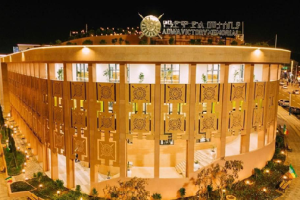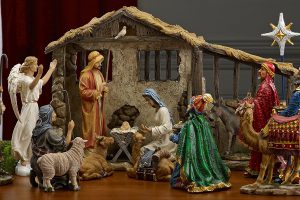BY MULUGETA GUDETA
The Ethiopian Calendar is roughly divided into three main seasons consisting of the New Year and the attending holidays such as Meskel or the founding of the True Cross, Christmas, The Baptism of Jesus Christ or Timket.
This period runs from September to roughly January and February. The second season consists of the four Ethiopian months of Yekatit, Megabit, Miazia and Ginbot, corresponding to the months of March, April, May and June. The third season is the rainy season that includes the Ethiopian months of Sene, Hamle and Nehassie that correspond to May, June and July.
The three seasons mentioned above are also linked to definite social and economic activities. For instance, the first batch of holidays coincides with the season of harvesting as the dark and cloudy rainy season gives way to sunshine, warmth and beauty.
This is the eve of the harvesting season when the landscape is covered with greenery, the rivers overflow and the flowers start to open their buds. September is the month that heralds the advent of plenty, happiness and hope. In Ethiopia, The New Year is celebrated in an environment of great expectations that will be realized in the following months when the harvesting seasons sets in and people rejoice in the gifts of nature.
Although the festive mood sets in starting from September, it reaches its crescendo at the time of Ethiopian Christmas and Timket that culminate in the month of January that usually ushers in what we may call the season of weddings. If you ask why most weddings, particularly in rural Ethiopia in particular take place in the month of Tir or January, the answer is clear.
This is the month of new harvests when there is plenty to eat and drink and money to buy the things that are needed to make weddings real moments of epiphany. Naturally, there is no better moment for weddings to take place than when there is planet to eat, the cattle have plenty of grass to graze and life is renewing itself in the bosoms of the new year.
In a way, we can say that social and economic activities are synchronized with natural cycles, particularly in the rural settings where the livelihoods of tens of millions of farmers much depend on the availability of rainfall and sunshine.
And what we have referred to, for the convenience of this article, as “the wedding season”, is not only regulated by nature but also come to an end according to social norms and traditions.
By the way, weddings depend on the cultural and traditional setting of each and every community across the nation. As there are more than 80 ethnic groups in Ethiopia, they are bound to organize weddings according to changes in ethnic traditions.
The diversity in Ethiopia’s ethnic composition makes it possible for each community to have its own style of organizing and executing weddings. As such the wedding rituals in south Omo zone, for instance, among the Hammer and Mursi people are not similar to the weddings ceremonies in the northern regions of Amhara and Tigray where the culture of Ivangadi, the evening singing and dancing rituals or bull-jumping is completely unknown.
By the same token, the people of the south differ from those in the western or eastern parts of the country in celebrating weddings or burials as the rituals are shaped under different economic and social settings.
Weddings also take place away from the rural areas and right into the cities and small towns where the wedding culture is, most often than not, a hybrid of traditional and modern or Western rituals. Instead of brides and grooms riding on horse or mule backs we have newlyweds driving in Mercedes Benz and Limousines and feasting in expensive hotels with the full retinues of modern music bands and the accompanying hanky-panky.
The foods and drinks are also different in rural and city weddings. So are the songs and lyrics. Modernization seems to have catch up with the city but it is mostly a caricature Western culture while there are also occasions when the weddings display a mixture of both traditional and Western features that coexist in an unfriendly social environment.
There is one distinction to be made while comparing rural and city weddings. In rural areas, the weddings take place at around harvest time while in cities like Addis Ababa weddings can take place at any time of the year provided that the newlyweds have the means of organizing them.
There are many people who marry during winter which is in rural settings, the period of hard work in the fields when farmers have no time for anything other than working in the wet field under heavy rains.
If there is one thing weddings in rural areas and in the cities share, it is the fact that they come to an end at the time of the biggest fasting season of the year which is called Lent here in Ethiopia and consists of daylong prayers, abstinence from meaty foods and alcoholic drinks and in the most extreme cases, abstinence from sex and the other pleasure soft the flesh.
Ethiopians both from the old and the new generations are very religious people as it can be seen for instance during the recent Christmas and Timket celebrations when youngsters, mainly boys, play a crucial role in organizing and managing the religious processions, carrying out street cleaning operations and keeping the peace, helping the poor and the disabled during the actual celebrations.
The two-month long fasting of Lent occupies a special place in the lives of Orthodox Christians. It is also a time of meditation and calm after the tumultuous five months that followed the New Year. Lent comes to an end in the Ethiopian month of Miazia (April), which is followed by two months of free consumption of meat and meaty foods plus the inevitable alcoholic beverages before the winter or the Ethiopian rainy season sets in and life returns to cold, rain and to farming life in the rural areas when farmers work hard in order to feed their families.
Schools are closed and youngsters help their parents in field works or look after the cattle. Both towns and rural areas sink into a kind of universal dampness and an air of melancholy and life becomes harder before it returns to normal.
The three months of Sene, Hamle and Nehassie (June, July and August) form the last stage of the seasonal cycle marked by overflowing rivers, difficult road communication and the separation of many families that cannot brave the elements to visit their siblings.
What is fascinating about Ethiopia is not only the seasonal changes, the cultural diversity or the spiritual celebrations. It is also the cultural and traditional wealth that these seasons represent or bring to our attention despite the grim fact that tourism is in sharp decline and incomes from the sector have drastically fallen.
It should however be born in mind that the global coronavirus pandemic is wreaking havoc on Ethiopia’s tourist sector and recovery is not yet in sight. This year’s income from tourism must be near to zero as visitors were discouraged by the pandemic from coming to the share in the popular celebrations.
Traditional tourism areas like Gondar and many parts of the south are feeling the heat, as economic activities like job creation has hit rock bottom.
Thousands of people who depend on tourism for their survival have left those places in search of better opportunities elsewhere. But all these grim realities are only temporary as the pandemic is going to stop somewhere sometime and better opportunities will come sooner or later.
What is important is to keep hope alive, pray and expect that next year’s holiday season will return without the chaos and misery of this year. The celebrations, weddings and feasts will inevitably return as long as people continue to hope and survive.
The Ethiopian Herald January 29/2021





